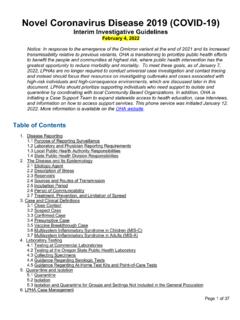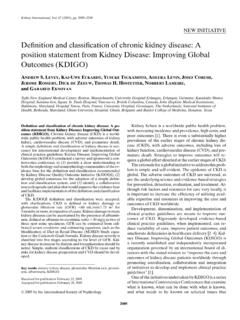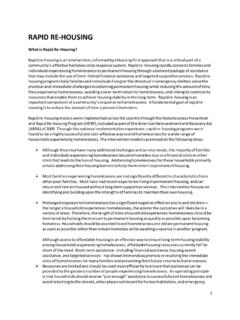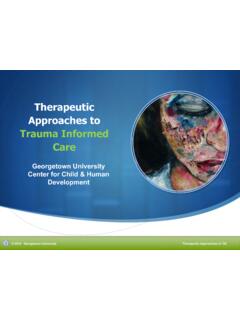Transcription of Simple versus Complex Trauma: A Clinician's Guide to …
1 Simple versus Complex Trauma: A Clinician's Guide to Indications, Treatment Plans, and therapeutic Methods Yves Wauthier-Freymann iHumanMind Concept, Belgium Association for Comprehensive Energy Psychology, and Francophone Association for Clinical Energy Psychology Abstract : This clinical report is intended to Guide practitioners in the identification and treatment of Simple and Complex trauma. It addresses questions such as: How can the clinician distinguish between a Simple trauma and a Complex trauma? How can attachment disorders be managed, and what impact do they have on the processing of traumatic memories?
2 What type of treatment plan is indicated once the nature of the trauma has been identified? Once these questions are answered, treatment can proceed in the most efficient manner. A structured approach for assessing trauma is presented, starting with the defining characteristics of Simple and Complex trauma. A three-stage treatment plan is presented for each of the two types of trauma. This structure can identify interventions that are safe and appropriate for the client, operating within a therapeutic range that avoids both the extremes: abreaction (overwhelming emotional release), and dissociation from emotional and physical sensation.
3 Intervention includes elements drawn from energy psychology, heart coherence, Internal Family Systems, and compassion focused therapy. This approach successfully remediates most psychological trauma. Keywords: Simple trauma, Complex trauma, energy psychology, treatment plan, client safety 1 One of the challenges that therapists face in mapping out a treatment plan for a new client is identifying the trauma at the heart of the behavior or problem for which the client is seeking treatment. Crucial to this venture is differentiating between a Simple and a Complex trauma.
4 A task that is not always easy but can determine how efficiently you help your client. Clients often present with a request that seemingly has nothing to do with the trauma itself: They might want to stop smoking, to weaken an addiction, to address an obsessive behavior, or to remediate an underlying, nagging anxiety, for example. One of the advantages of a more clinical approach, then, is that it recognizes the actual scope of the client's trauma, apart from the client's self-identified symptoms. In so doing, therapists can redefine the problematic behavior by helping clients identify the connection between earlier traumas and presenting symptoms thereby helping restore their autonomy and regain real control over and contact with their internal selves.
5 In this article, I offer ways of identifying between Simple and Complex traumas and present steps for creating treatment plans that are tailored to these traumas. Simple Traumas (Type I). Definition A trauma comprises a physical or psychological wound inflicted on a person as well as the local or general consequences of that wound. A Simple trauma can be seen as the trace, the emotional imprint, accompanied by physical sensations and negative cognition, that embed a traumatic event within the individual. In general, a Simple trauma stems from a single event, not one repeated over time.
6 It seems easy to identify but sometimes the complexity of the trauma is hidden by the resilience of the client. The resilience is his own skill to adapt himself quickly to every new situation that could cause difficulties. It is the survival instinct. Treatment Plan The treatment plan for a Simple trauma is itself relatively Simple . Ideally, the therapist works on the oldest event related to the problem. A floatback is a tool that is used to reactivate the individual's access to his or her oldest memories that are directly connected with whatever is triggering the individual today.
7 The therapist can use a floatback to assist the client's subconscious and memory to effortlessly return to that core memory or event. When the client is clearly fully in contact with those emotions and the cognition has been clarified, the therapist should ask her to close her eyes and quickly ask her what age she 2 remembers herself as being on the first occasion she experienced this emotion. When the client's floatback is guided properly, an image, feelings, or particular thought will instantly emerge. This very often enables her to identify a core scene, from which the therapist can start to treat past events.
8 Once the target event from the past has been desensitized, we can move back to the present and desensitize the triggers there as well. As a last step, we check a future projection by asking the client to envision herself in the situation from the past and then to imagine herself reexperiencing the same type of event. If the treatment has been effective, there will be no doubt, no negative emotion, no limiting thoughts, and no unpleasant feelings related to the situations addressed. Summary of Treatment Plan 1. Past (floatback): Work on the past by focusing on the most emotionally reactive event.
9 2. Next, focus on the present. 3. Finally, ask the client to visualize him- or herself in the future, faced with a similar problem. Complex Traumas (Type II). Definition Complex trauma stems from an accumulation of traumatic events endured or repeated over time. These events may be of the same nature or different. They may be concentrated in time or, on the contrary, spread out over many years. Some of the different types of trauma, and the symptoms that identify them, are summarized below. Acute stress is characterized by the following symptoms: Distress Brief psychotic episodes Occurring up to 1 month after the traumatic event.
10 Posttraumatic stress (lasting more than 1 month), chronic stress (lasting more than 6. months), and delayed stress share the following symptoms: Reexperiencing: Can include recurring thoughts on the violence endured;. dwelling on negative thoughts; experiencing intrusive memories of all or part of the event ( , feelings, pain, noise, or words); having flashbacks, illusions, recurring dreams, or intense nightmares that are perceived with a high level of 3 anxiety and distress; or reacting suddenly as though the event were going to happen again.






